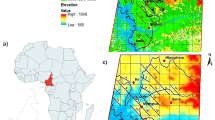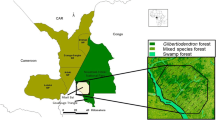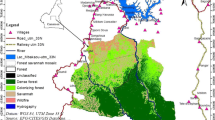Abstract
A study on the distribution and population density of the western lowland gorilla (Gorilla g. gorilla) and the central chimpanzee (Pan t. troglodytes) was undertaken between December 1997 and August 2000 in the Campo and Ma’an Forests in southwestern Cameroon. The aim of this survey was to estimate the densities of the apes in different parts of the area, to assess the importance of the region for the conservation of these endangered species and to determine the influence of human activities such as logging and hunting. The survey was based on night nest counts on a total of 665.5 km of line transects. The overall density in the Campo Forest was estimated at 0.2 gorillas/km2 and at 0.63–0.78 chimpanzees/km2. The overall density of chimpanzees in the Ma’an Forest was estimated at 0.8–1 individuals/km2. Gorilla density in this area was too low to allow an estimation. The highest gorilla nest density was found in secondary forest. The gorilla density in unlogged forest was significantly lower. Chimpanzees showed a clear preference for less disturbed areas. In unlogged forest, old secondary forests (logging more than 23 years ago) and areas of recent logging with large remaining patches of primary forest, significantly higher densities were calculated than inside the more heavily exploited logging concession. In areas with both logging and high hunting pressure both species were rare or even absent. The Campo Ma’an area is considered a very important area for the conservation of gorillas and chimpanzees. Conservation measures are urgently required to reduce the impact of logging and hunting. The creation of the Campo Ma’an National Park in January 2000 is an important measure to preserve the unique biodiversity in this so far hardly protected area.

Similar content being viewed by others
References
Anderson JR, Williamson EA, Carter, J (1983) Chimpanzees of Sapo Forest, Liberia: density, nests, tools and meat-eating. Primates 24:594-601
Bermeyo M (1999) Status and conservation of primates in Odzala National Park, Republic of the Congo. Oryx 33:323–331
Blom A, Almasi A, Heitkonig IMA, Kpanou JB (2001) A survey of the apes in the Dzanga-Ndoki National Park, Central African Republic: a comparison between the census and survey methods of estimating the gorilla (Gorilla gorilla gorilla) and chimpanzee (Pan troglodytes) nest group density. Afr J Ecol 39:98–105
Brugerie D, Sakom D (2001) Population density and nesting behaviour of lowland gorillas (Gorilla gorilla gorilla) in the Ngotto forest, Central African Republic. J Zool 255:251–259
Buckland ST, Anderson DR, Burnham KP, Laake JL (1993) Distance sampling: estimating abundance of biological populations. Chapman and Hall, London
Calvert J (1985) Food selection by western gorillas (G. g. gorilla) in relation to food chemistry. Oecologia 65:236–246
Carroll RW (1986) Status of the lowland gorilla and other wildlife in the Dzangha-Sangha region of southwestern Central African Republic. Primate Conserv 7:38–41
Carroll RW (1988) Relative density, range extension, and conservation potential of the lowland gorilla (Gorilla gorilla gorilla) in the Dzanga-Sangha region of southwestern Central African Republic. Mammalia 52:309–323
Chapman C, Wrangham RW, Chapman LJ (1995) Ecological constraints on group size: An analysis of spider monkey and chimpanzee subgroups. Behav Ecol Sociobiol 36:59–70
Doran D (1997) Influence of seasonality on activity patterns, feeding behavior, ranging, and grouping patterns in Tai chimpanzees. Int J Primatol 18:183–206
Fay JM (1989) Partial completion of a census of the western lowland gorilla (Gorilla g. gorilla (Savage and Wyman)) in southwestern Central African Republic. Mammalia 53:203–215
Fay JM, Agnagna M (1992) Census of gorilla in northern Republic of Congo. Am J Primatol 27:275–284
Fay JM, Agnagna M, Moore J, Oko R (1990) Gorillas (Gorilla g. gorilla) in the Likouala swamp forests of North Central Congo: preliminary data on populations and ecology. Int J Primatol 10:477–486
Foran DR, Hixson JE, Brown WM (1988) Comparisons of ape and human sequences that regulate mitochondrial DNA transcription and D-loop DNA synthesis. Nucl Acids Res 16:5841–5861
Fruth B, Hohmann G (1994) Comparative analyses of nest building behavior in bonobos and chimpanzees. In: Wrangham RW, McGrew WC, De Waal FBM, Heltne PG (eds) Chimpanzee cultures. Harvard University Press, Cambridge, Mass., pp 109–128
Furuichi T, Inagaki H, Angoue-Ovongo S (1997) Population density of chimpanzees and gorillas in the Petit Loango Reserve, Gabon: employing a new method to distinguish between nests of the two species. Int J Primatol 18:1029–1046
Ghiglieri MP (1984) The socio-ecology of chimpanzees in Kibale Forest, Uganda. PhD thesis, University of California, Davis
Goodall J (1968) The behaviour of free-living chimpanzees in the Gombe Stream Reserve. Anim Behav Monogr 1:163–311
Goodall J van L, Bandora E, Bergmann B, Busse B, Matama H, Mpongo E, Pierce A, Riss D (1979) Intercommunity interactions in the chimpanzee population of the Gombe National Park. In: Hamburg D, McCown E (eds) The great apes. Benjamin and Cummings, Menlo Park, Calif., pp 13–53
Hall JS, White LJT, Inogwabini BI, Omari I, Simons Morland H, Williamson EA, Saltonstall K, Walsh P, Sikubwabo C, Bonny D, Kiswele KP, Vedder A, Freeman K (1998) Survey of Grauer’s Gorillas (Gorilla gorilla graueri) and Eastern Chimpanzees (Pan troglodytes schweinfurthi) in the Kahuzi-Biega National Park lowland sector and adjacent forest in eastern Democratic Republic of Congo. Int J Primatol 19:207–235
Harcourt AH, Stewart KJ, Inahoro IM (1989) Nigeria’s gorillas: a survey and recommendations. Primate Conserv 10:73–76
Harris D, Fay JM, Macdonald N (1987) Report of gorillas from Nigeria. Primate Conserv 8:40
Hashimoto C (1995) Population census of the chimpanzees in the Kalinzu forest, Uganda: comparison between methods with nest counts. Primates 36:477–488
Hoppe-Dominik B (1991) Distribution and status of chimpanzees (Pan troglodytes verus) on the Ivory Coast. Primate Rep 31:45-75
Hoshino J, Mori A, Kudo H, Kawai M (1984) A preliminary report on the groupings of mandrills (Mandrillus sphinx) in Cameroon. Primates 25:295-307
Howard P (1991) Nature conservation in Uganda’s tropical forest reserves. IUCN, Gland, Switzerland
Ihobe H (1995) The diurnal primate fauna and population densities of Tschego chimpanzees in Southwestern Congo. Afr Stud Monogr 16:35–44
Kano T (1983) An ecological study of the pygmy chimpanzees (Pan paniscus) of Yalosidi, Rep. of Zaire. Int J Primatol 4:1-31
Laake JL, Buckland ST, Anderson DR, Burnham KP (1994) Distance user’s guide. Colorado Cooperative Fish and Wildlife Research Unit, Colorado State University, Fort Collins, Colo.
Lee PC, Thornback J, Bennett EL (1988) Threatened primates of Africa: the IUCN red data book. IUCN, Gland, Switzerland
Letouzey R (1968) Ètude phytogéographique du Cameroun. Lechevalier, Paris
Mitani M (1992) Preliminary results of the studies on wild western lowland gorillas and other sympatric diurnal primates in the Ndoki Forest, Northern Congo. In: Itoidawa N, Sugiyama Y, Sackett GP, Thompson RKR (eds) Topics in primatology. University of Tokyo Press, Tokyo, pp 215–224
Nishida T, Hiraiwa-Hasegawa M, Hasegawa T, Takahata Y (1985) Group extinction and female transfer in wild chimpanzees in the Mahale National Park, Tanzania. Z Tierpsychol 67:284–301
Plumptre AJ, Reynolds V (1994) The effect of selective logging on the primate populations in the Budongo Forest Reserve, Uganda. J Appl Ecol 31:631–641
Remis MJ (2000) Preliminary assessment of the impacts of human activities on gorillas (Gorilla gorilla gorilla) and other wildlife at Dzanga-Sangha Reserve, Central African Republic. Oryx 34:56–65
Rogers ME, Williamson EA (1987) Density of herbaceous plants eaten by gorillas in Gabon: some preliminary data. Biotropica 19:278–281
Rogers ME, Maisels F, Williamson E, Fernandez M, Tutin C (1990) Gorillas diet in the Lopé Reserve, Gabon. Oecologia 84:326–339
Schaller GB (1963) The mountain gorilla, ecology and behavior. University of Chicago Press, Chicago
Skorupa JP (1986) Responses of rain forest primates to selective logging in Kibale Forest, Uganda: a summary report. In: Benirschke (ed) Primates. The road to self-sustaining populations. Springer, Berlin Heidelberg New York, pp 57–70
Strohmayer KAK, Ekobo A (1991) Biological surveys of southeastern Cameroon. The Wildlife Conservation Society, Washington, D.C.
Struhsaker TT (1975) The red colobus monkey. University of Chicago Press, Chicago
Thomas D, Thomas J (1993) Botanical and ecological survey of the Campo Ma’an Area. A report to the World Bank. Tropenbos Foundation, Wageningen, Netherlands
Tutin CEG, Fernandez M (1984) Nationwide census of gorilla (Gorilla g. gorilla) and chimpanzee (Pan t. troglodytes) populations in Gabon. Am J Primatol 6:313–336
Tutin CEG, Fernandez M, Rogers ME, Williamson EA, McGrew WC (1991) Foraging profiles of sympatric lowland gorillas and chimpanzees in the Lopé Reserve, Gabon. Philos Trans R Soc Lond B 334:179–186
Tutin CEG, Parnell RJ, White LJT, Fernandez M (1995) Nest building by lowland gorillas in the Lopé Reserve, Gabon: environmental influences and implications for censusing. Int J Primatol 16:53–76
Waller JC, Reynolds V (2001) Limb injuries resulting from snares and traps in chimpanzees (Pan troglodytes schweinfurthii) of the Budongo Forest, Uganda. Primates 42:135–139
WCS (1996) The Lobéké forest, southeast Cameroon. Summary of activities, 1988–1995. The Wildlife Conservation Society, Washington, D.C.
White LJT (1992) The effects of mechanised selective logging on the flora and mammalian fauna of the Lopé Reserve, Gabon. PhD Thesis, University of Edinburgh, Edinburgh
White LJT, Tutin CEG (2001) Why chimpanzees and gorillas respond differently to logging: a cautionary tale from Gabon. In: Weber W, White L, Naughton-Treves L (eds) African rain forest ecology and conservation: an interdisciplinary perspective. Yale University Press, New Haven, Conn., pp 449–462
Williamson L, Usongo L (1995) 1. Survey of primate populations and large mammal inventory., 2. Survey of elephants, gorillas and chimpanzees. Report to ECOFAC Cameroon. AGRECO CTFT
Wrangham RW (1977) Feeding behaviour of chimpanzees in Gombe National Park, Tanzania. In: Clutton-Brock TH (ed) Primate ecology. Academic Press, London, pp 503–538
Wrangham RW, Clark AP, Sabirye-Basuta G (1992) Female social relationships and social organization of Kibale Forest chimpanzees. In: Nishida T, McGrew W, Marler P, Pickford M, De Waal F (eds) Topics in primatology. University of Tokyo Press, Tokyo, pp 81–98
YamagiwaJ (1995) Densities of apes’ food trees and primates in the Petit Loango Reserve, Gabon. Afr Stud Monogr 16:181–193
Acknowledgements
This study was financed by the University of Berlin (FNK-Freie Komission zur Förderung des wissenschaftlichen Nachwuchses der Freien Universität Berlin). Twelve months of data collection and 5 months of data analysis were financed by the Campo Ma’an Project of Tropenbos Foundation. We wish to thank the FNK, University of Berlin, for the financial support. We are very grateful to Mrs. Christiane von Alten for her help. We wish to thank the team of the Campo Ma’an Project and the Tropenbos Cameroon Project for their cooperation and support. We are very grateful to Prof. Dr. Carsten Niemitz for his help, support and advice throughout the study. We would also like to thank Mr. Guillaume Akogo Mvogo, Conservation delegate of the Ministry for Environment and Forests of the Cameroon Government (MINEF) and Mr. Ela Mintja, Forestry delegate of the MINEF for their cooperation and help. We thank the Max Planck Institute for Evolutionary Anthropology especially Dr. Linda Vigilant and Miss Brenda Bradley for undertaking the genetic analyses of the hair samples. We would also like to express our gratefulness to our local assistants, Innocent Medjo and Austin Nnanga, who supported our work in the field. We wish to thank the numerous villagers of the Campo and Ma’an region for their cooperation and willingness to contribute information on village hunting areas and hunting activities.
Author information
Authors and Affiliations
Corresponding author
About this article
Cite this article
Matthews, A., Matthews, A. Survey of gorillas (Gorilla gorilla gorilla) and chimpanzees (Pan troglodytes troglodytes) in Southwestern Cameroon. Primates 45, 15–24 (2004). https://doi.org/10.1007/s10329-003-0058-4
Received:
Accepted:
Published:
Issue Date:
DOI: https://doi.org/10.1007/s10329-003-0058-4




